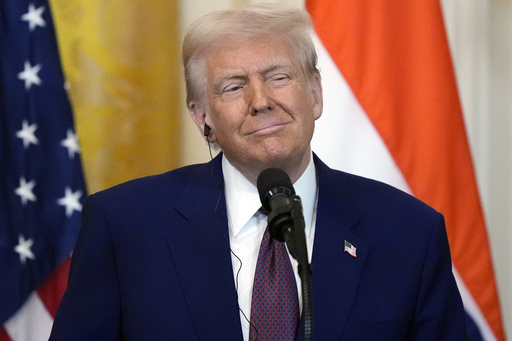The United States is set to impose a 25% tariff on products imported from India, accompanied by an additional import tax as a consequence of India’s continued purchase of Russian oil. This was announced by President Donald Trump on Wednesday, marking a significant development in international trade relations.
These new tariffs are part of a broad spectrum of trade actions which include executing orders associated with Brazil, copper, and imports of goods priced under $800. In addition to this, a reduced 15% tariff will be applied to imports from South Korea, including their automobiles. These moves are seen as preliminary steps for the introduction of Trump’s amended tariff plan scheduled for Friday. The White House has showcased these measures as evidence of Trump’s adeptness in negotiation, despite ongoing concerns about the potential negative impact on economic growth and inflation.
In addressing India on his Truth Social platform, Trump acknowledged the nation as a friend yet criticized its high tariff rates on U.S. products. Moreover, he highlighted India’s military and oil purchases from Russia, suggesting these actions support Moscow’s conflict in Ukraine. Consequently, Trump plans to introduce an additional penalty starting on Friday, coinciding with the launch of his revised tariffs directed at various countries.
While discussing the impending tariffs with reporters, Trump noted that discussions with India over trade continue, despite the looming deadline. He stated, “We’re talking to India now. We’ll see what happens.” The Indian government, in response, has expressed that it is currently evaluating the implications of Trump’s tariff announcements.
For months, India and the U.S. have been engaged in negotiations aimed at creating a “fair, balanced and mutually beneficial” bilateral trade agreement. The Indian Trade Ministry confirmed that New Delhi is still committed to this objective.
In addition to tariffs on India, Trump authorized separate orders levying 50% duties on copper imports and justified similar tariffs on Brazil. This decision was attributed to Brazil’s legal actions against former President Jair Bolsonaro and its treatment of U.S. social media companies. Furthermore, an order was signed targeting the so-called “de minimis” loophole, which had previously allowed goods valued under $800 to enter the U.S. without duty, predominantly benefiting Chinese imports.
South Korea brokers a slightly lenient agreement, with a promised 15% tariff, inferior to the previously threatened 25%. Additionally, South Korea agreed to procure $100 billion worth of energy resources from the U.S. and to invest $350 billion in ventures chosen by the American president.
An arrangement with Pakistan, aimed at the exploration of its oil resources, was revealed alongside news of ongoing trade discussions with China, as noted by Treasury Secretary Scott Bessent’s briefing to Trump.
Trump’s announcement follows recent negotiations of trade agreements with the European Union, Japan, the Philippines, and Indonesia, each aimed at opening foreign markets to American products and facilitating higher U.S. import tax rates. Trump’s strategic use of tariffs seeks to mitigate budget deficits associated with recent tax cuts and aims to bolster domestic manufacturing jobs. Yet, economists forecast possible economic downsides, such as reduced growth and heightened inflation, due to the additional costs borne by U.S. businesses and consumers.
There is a possibility of further tariffs regarding trade partners engaging with Russia, as well as potential tariffs on pharmaceuticals and semiconductors. According to Kevin Hassett, director of the White House National Economic Council, future announcements regarding tariffs on Russian-linked Indian trade will be forthcoming.
Europe has voiced opposition to the 15% tariff levied on U.S. allies, prompting discussions for alternative global alliances. French President Emmanuel Macron indicated the need for Europe to enhance its sovereignty and competitive edge, some of which lines up with enduring dialogues with the U.S.
The initiative to forge stronger ties with India aligns with the strategic goal of counterbalancing China’s influence. The positive dynamic between Indian Prime Minister Narendra Modi and Trump has encouraged trade dialogue, although the newly imposed tariffs might impede India’s ambition to double its bilateral trade with the U.S. to $500 billion by 2030. Five rounds of bilateral trade negotiations have occurred, yet the U.S. seeks greater market entrance and zero tariffs on most exports while India remains protective over sectors employing large population segments, such as agriculture and dairy.
In the preceding year, the U.S. reported a $45.8 billion trade deficit with India, signifying greater imports than exports. India’s vast population and strategic geopolitical position add complexity to this dynamic, particularly given its existing rapport with Russia and non-alignment with Western sanctions related to the Russian-Ukrainian conflict.
These new tariffs might disadvantage India compared to other U.S. trading partners like Vietnam and Bangladesh. Ajay Sahai, director general of the Federation of Indian Export Organisations, expressed uncertainty regarding the details and cumulative effects of tariffs, noting, “We are back to square one as Trump hasn’t spelled out what the penalties would be in addition to the tariff.” The demand for Indian goods could see a decline as a result.


